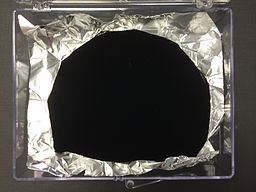We all know what the color ‘black’ is. If I ask anyone, I will get different responses. From the familiar blackboard in the classroom to the ubiquitous asphalt of the roads. Some might recall, with fondness, it as the color of the little dress on their high-school prom date. Others might be more correct, and remind me that “true” black is the absence of any reflected light. And point me towards the nearest black hole (at the center of the milky way or on the Sagittarius arm of it, depending on what one believes [1]).
Even then, when I show the above graphic, all (including me) will be unequivocal in declaring the colors to be shades of black. Although those are hues of gray. Such befuddlement ails us all. As Dr. Stephen Westland, professor of color science and technology at Leeds University, is right in saying, “Unless you are looking at a black hole, nobody has actually seen something which has no light.” [2]
Given our feeble attempts at defining and rendering ‘Black’, it becomes quite a challenge to explain Vantablack – the blackest material known [3, 4], where Vanta is an acronym for Vertically Aligned Nano Tube Arrays. Although, NASA might argue that their super-black deserves that title [5]. It is easy to visualize Vantablack as a forest of carbon nano tubes. The tubes are stacked in a vertical orientation, with the length of the individual tubes being much much larger than their diameter.
Yet, that still doesn’t explain why it is the ‘blackest’ of blacks and could rewrite and replace all previous conceptions of black [6]. When light hits the Vantablack surface, it gets trapped in between the carbon nano tubes. The photons undergo a lot of collisions with the walls of these tubes. They lose their energies as heat to the walls and the tiniest amount is reflected back as light, all of 0.035 % [2, 7].
Such properties make it very exciting as future prospects. From manufacturing telescope coatings, where even the tiniest speck of scattered light can seriously affect its contrast and resolving power. To the defense and stealth sectors, who find the material extremely fascinating [7].
Yet, it is still baffling to answer how does it feel to see the blackest material known. We understand a surface by its depth or its topological features. These features change reflectance. But for Vantablack, even when it is crumpled up, it defies perception. “You expect to see the hills and all you can see … it’s like black, like a hole, like there’s nothing there. It just looks so strange”, as Surrey Nanosystems CTO Ben Jensen puts it [2].
Vantablack is the darkest material we have that is as close to perceiving what a black hole would look like. This might be a bit disconcerting for us in the future, expecting to see textures but being greeted with an abyss. “And if you gaze long into an abyss, the abyss also gazes into you.”
-Soham Roy
References:
[1] http://www.universetoday.com/75723/where-is-the-nearest-black-hole/
[3] https://www.surreynanosystems.com/vantablack
[4] E. Theocharous et al., Optics Express 2014, 22, 7290-7307.
[5] http://www.nasa-usa.de/topics/technology/features/super-black-material.html
[6] https://www.theguardian.com/fashion/shortcuts/2014/jul/14/vantablack-nanofabric-new-black

